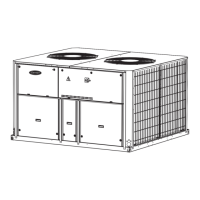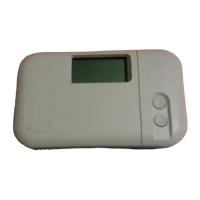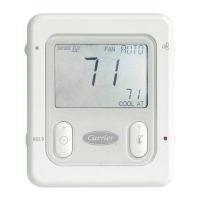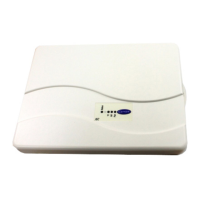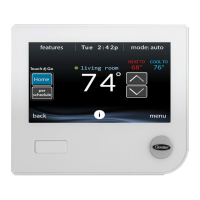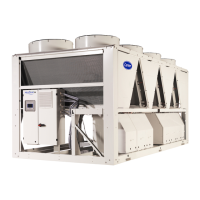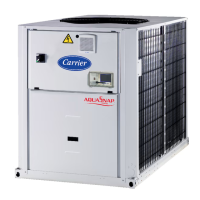f
5625
(14.3)
r
_UUUUUU _
ooooooc
ooooooc
oooooc
oooooc
oooo
1
o
o
o
o
3.25
(83)
i "
(12.7)
NOTE: Dimensions are in inches. Dimensions in ( ) are in millimeters.
Fig. 24 -- Indoor Air Quality (C02) Sensor
(33ZCSENCO2)
8O
z
_oo
wo
D_ v
LU<40
_:LW
o_
_j_- 20
u-23
<
0
soo zoo 9oo 1100 1300 15oo1700 190021oo23oo25oo
002 CONCENTRATION (PPM)
Fig. 25 -- Ventilation Rated Based on
CO2 Set Point
Indoor Air Quality Sensor WMng -- To wire tile sensors
after they ale mounted in the conditioned air space and return
air duct, see Fig. 26 and the instructions shipped with file sen-
sors. For each sensol: use two 2-conductor 18 AWG twisted-
pair cables (unshielded) to connect the sepm'ate isolated 24 vac
power source to the sensor and to connect the sensor to the con-
trol board terminals. To connect the sensor to the control board,
identify the positive (+) PIN-8 and ground (GND) PIN-7 termi-
nals on the sensor and connect the positive terminal to terminal
RHflAQ and connect the ground terminal to terminal GND.
HUMIDITY SENSOR (WALL-MOUNTED)INSTALLA-
TION -- The accessory space humidity sensor is installed on
an interior wall to measure the relative humidity of the air with-
in the occupied space. See Fig. 27.
The use of a standard 2 x 4-in. electrical box to accommo-
date the wiring is recommended for installation. The sensor can
be mounted dilectly on the wall, if accepkLble by local codes.
If the sensor is installed directly on a wall surface, install the
humidity sensor using 2 screws and 2 hollow wall anchors
(field-supplied); do not overtighwn scrams. See Fig. 15.
Do NOT clean or touch the sensing element with chemical
solvents; they can permanently &unage the sensol:
The sensor must be mounted vertically on the wall. The
Carrier logo should be oriented correctly when the sensor is
properly mounted.
DO NOT mount the sensor in drafiy areas such as netu heat-
ing or air-conditioning ducts, open windows, f_ms, or over heat
sources such as baseboard heaters, radiators, or wall-mounted
light dimmel.s. Sensors mounted in those areas will produce in-
accurate readings.
Avoid corner locations. Allow at least 4 ft between the sen-
sor and any cornel: Airflow netu corners tends to be reduced,
resulting in erratic sensor leadings.
Sensor should be vertically mounted approximately 5 ft up
from the flool: beside the space temperatme sensol:
For distances up to 500 feet, use a 3-conductor. 18 or 20
AWG cable. A communication cable can be used, although the
shield is not required. The shield must be removed from the
sensor end of the cable if this cable is used. See Fig. 28 for
wiring details.
The power for the sensor is provided by the control board.
The board provides 24 vdc for the sensol: No additional power
source is required.
To wire the sensm; perform the following:
1. At the sensor, remove 4-in. of jacket from the cable. Strip
I/4-in. of insulation from each conductol: Route the cable
through the wire clearance opening in the center of the
sensoc See Fig. 28.
2. Connect the RED wire to the sensor screw terminal
mmked (+).
3. Install one lead from the resistor (supplied with the sen-
sor) and the WHITE wire, into the sensor screw terminal
maned (-). After tightening the screw terminal, test the
connection by pulling gently on the resistor lead.
4. Connect the remaining lead from the resistor to the
BLACK wire and secure using a closed end type crimp
connector or wire nut.
5. Using electric_fl tape, insulate any exposed resistor lead to
prevent shorting.
6. At the control box, remove the jacket from the cable and
route the RED conductor over to the left side of the con-
trol board. Route the remaining conductors to the right
side of the control board.
7. Strip V4-in. of insulation from each conductor and equip
each with a l/4-in, female quick connect terminal.
8. Connect the RED wire to termimd +24v on the control
board.
9. Connect the BLACK wire to terminal GND on the con-
trol board.
10. Connect the WHITE/CLEAR wire to terminal RHfIAQ
on the control board.
11. Connect shield to ground (if shielded wire is used).
Remote Occupancy Contact -- The remote occu-
pancy input 04 pin 1) has the capability to be connected to a
normally open or normally closed occupancy diy contact. Wile
the dry contact as show in Fig. 29 between J4 Pin 1 and
24 VAC Jl Pin 1. The 24 vac necesstuy to supply the VVT®
zone controller remote occupancy contact input is supplied
using the zone controller
Connect the Outputs lWire the zone controller's
outputs (fan, staged heat, valves) as shown in the applicable
wiring diagrams in Fig. 5-13.
21

